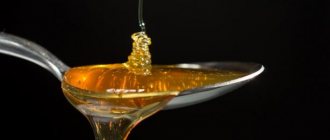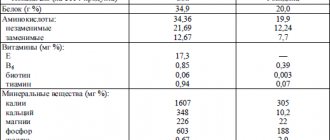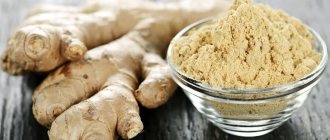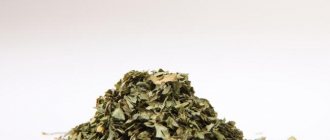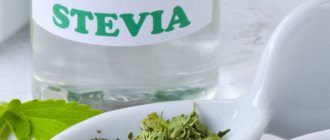When a sweetener is the optimal solution to a problem
Don’t despair if your doctor or nutritionist categorically demands that you eliminate sugar from your diet. Not eating sweets and giving up sugar are completely different things. A sugar substitute can be a solution to the problem.
In addition, you may find consolation in the fact that sugar is not only a source of extra calories, but also a product that increases the risk of developing cardiovascular diseases and caries. Excessive consumption of sweets negatively affects the condition of the skin and mucous membranes, and also increases appetite.
What can you replace sugar with? Variety of species
Today, several types of sugar substitutes have been developed and are successfully used in the world. All of them are divided into two groups: those participating in metabolic processes and those not participating (intense sweeteners). Each group includes several sweeteners, let's look at some of them in more detail.
Sweeteners involved in metabolic processes
Among them, fructose
. It is approximately 1.5-1.7 times sweeter than sugar and has a pleasant taste. Despite the fact that the sweetener contains approximately the same calories as sugar, due to its greater sweetness, significantly less is consumed, which reduces the overall calorie content of the diet. Fructose is naturally found in natural fruits, berries and vegetables. Fructose, unlike sugar, has a low glycemic index of 19 units. Therefore, its use does not cause a sharp increase in the level of glucose in a person’s blood; the release of energy occurs much more slowly than when consuming regular sugar. It can also enhance the natural taste of fruits and berries - preserves, jams, and desserts made with fructose are tastier than those made with sugar.
There is a misconception that consuming fructose can lead to excess weight. However, a recent study found that when fructose replaces other dietary carbohydrates of similar calorie content, it has no more effect on body weight or blood triglyceride levels than the latter. Thus, excessive consumption of fructose, glucose or saturated fat leads to an equal increase in fat content in the liver. Excess consumption of both fructose and glucose reduces the liver's sensitivity to insulin. Thus, these effects are not unique to fructose, as some scientists previously claimed, and are actually due to excess calorie intake. All this allows us to conclude that an increase in caloric intake above the norm ultimately always leads to an increase in body weight, if not balanced by physical activity.
Erythritol
, or “melon sugar,” is a popular new natural sugar substitute that won’t spike your blood sugar. It is a highly water-soluble, odorless crystal, very similar to sugar. The calorie content of erythritol is so low that in most countries it is accepted as zero. Erythritol does not cause tooth decay. The sweetness level of erythritol is about 70% of that of regular sugar. The substitute is well tolerated by the body even in slightly larger dosages than regular sugar, which distinguishes it from sorbitol and xylitol, which have a laxative side effect. Recently, erythritol can often be found in combination with stevia, as it can improve its specific taste.
Sorbitol
– this natural sweetener is also popular among many people. Like xylitol, its chemical composition is a sugar alcohol. The level of sweetness is inferior to sugar. The calorie content of sorbitol is half that of regular sugar. Sorbitol is widely used in medical practice in the preparation of diets for diabetics and overweight people, since it has a very low glycemic index - only 9 units. However, the daily intake of sorbitol should not exceed 40 grams, since excessive consumption may cause a laxative effect.
Benefits of giving up sweets
The benefits of not consuming refined sugar and products containing it have been confirmed by research by doctors in Europe, Russia, and the USA:
- effective prevention of diabetes mellitus;
- it makes it easier to control body weight - sweet foods fill you up for a short time, hunger occurs 30-40 minutes after eating a cake, and if you choose lean meat with a portion of vegetable salad, which has 3-4 times fewer calories, your appetite will appear in 2-3 hours;
- the risk of developing hypertension is reduced, blood vessels remain elastic longer, which facilitates the functioning of the heart and the supply of oxygen and nutrients to the brain;
- people who do not abuse sweets remain physically active longer and maintain clarity of thinking;
- in adolescence, the number of skin rashes decreases, and in adulthood, the complexion improves, and later wrinkles appear.
What kind of beast is stevia?
Sugar substitute stevia is a common herb, or rather a South American perennial plant of the Asteraceae family.
The Indians knew about its beneficial properties 1500 years ago.
It was used to sweeten traditional matcha tea and treat heartburn and heart disease.
But it gained the greatest popularity around the world at the end of the 20th century, when the problem of obesity caused by excess sugar in food began to grow, and artificial sweeteners began to be suspected of causing cancer.
Why is it difficult to give up sweets?
When refined sugar is consumed, the brain produces serotonin and dopamine - pleasure hormones. It is addictive like a narcotic drug. Refusing it can cause discomfort:
- irritability, depression, anxiety;
- decreased performance, rapid fatigue during physical and intellectual work;
- headache;
- insomnia;
- muscle pain;
- violation of the diet - at the usual time of breakfast, lunch, dinner, appetite disappears, but at inopportune times there is a strong desire to eat something sweet.
If you show willpower and give up sweets, the negative consequences of refusal will disappear in 2-3 weeks: sleep and appetite will improve, you will feel lightness and a surge of energy, your well-being and mood will improve.
Is “sugar grass” useful and why?
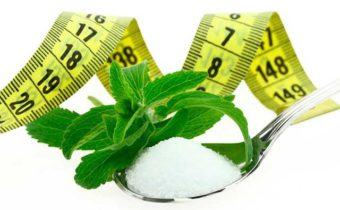
Steviol glycosides - stevioside and rebaudioside A - have a stimulating effect on pancreatic cells responsible for the production of insulin and increase sensitivity to it.
This promotes protein synthesis and the burning of carbohydrate and fat reserves, which helps in weight loss .
In addition, they have powerful antitumor and anti-inflammatory effects and lower blood pressure.
In addition to glycosides, stevia contains many compounds that make it extremely useful:
- vitamins (A, C, E, B, PP), minerals (iron, chromium, zinc, manganese, copper, phosphorus) - improve skin condition, metabolic and digestive processes, reduce cravings for sweets and fatty foods;
- apigenin and caffeic acid are powerful antioxidants;
- campesterol reduces cholesterol absorption;
- humic acid has a disinfecting and anti-inflammatory effect.
For all its benefits, stevia does have a number of side effects. Like any plant product, it can cause allergic reactions. According to doctors, it is better not to use it as food for pregnant women and children, because... they have increased sensitivity to food. If consumed excessively, it may lower blood pressure; stevia is especially harmful for people prone to hypotension. If abused, it can cause a drop in blood sugar, which will negatively affect the course of diabetes.
Harm from eating sugar
Nutritionists recommend that healthy people limit their sugar intake: no more than 25-30 grams per day. But, according to statistics, the average rate of its consumption in Russia is 107 grams, in the USA – 160 grams.
The sweet life brings bitter consequences:
- obesity - with each spoon of white crystals we get 20-30 calories, which turn into fat deposits, weight increases, it becomes harder to move, and the disease develops;
- diabetes;
- decreased immunity;
- atherosclerosis;
- damage to the walls of blood vessels;
- decreased strength of bone tissue;
- the proliferation of microorganisms in the mouth that destroy tooth enamel.
When breaking down and eliminating sweets, the stomach, liver, kidneys, and pancreas experience increased stress, which provokes malfunctions in their work and the development of diseases of the endocrine, digestive and excretory systems.
Stevia sweeteners: how not to make a mistake with the choice
Honey grass on store shelves is presented in several types and forms:
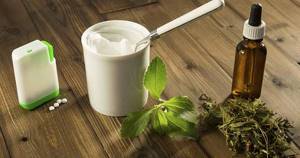
- Fresh leaves . Perfect for brewing yourself, adding to compotes and hot drinks. A drink made from stevia leaves removes toxins, lowers cholesterol, and helps lose weight.
- Tablets are the most convenient and versatile type of stevioside-based sweeteners. They usually dissolve quickly, they are convenient to take with you, there is no risk of overdoing the quantity; found application in all areas of cooking.
- Powdered extracts. Depending on the quality of the raw materials used in their production, they may have different taste and sweetness. The concentration of steioside is also important - on IHerb there are such concentrated preparations that one pinch is enough for a cup of tea. Great for baking and desserts! For example, an excellent product in terms of price and quality ratio.
- Liquid additives – syrup and alcohol tincture. You can prepare it at home by evaporating the stevia decoction until thick or by infusing the dry leaves in vodka (20 grams of herb per glass of vodka). The liquid extract has a more pronounced bitter taste, which not everyone will like. But honestly, it’s easier to buy ready-made, where cleaning removes all possible bitterness. Also convenient for preparing delicious treats.
- Dried leaves. They are sweeter than fresh ones, they can also be consumed as a separate drink, or added to hot drinks, cereals, fruit purees, and marinades.

The easiest way is to buy stevia sugar on iherb. Here is a selection of quality forms.
Natural sugar in pp-cooking
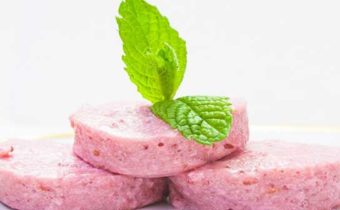
Stevia has a specific bitter-sweet taste, which takes a little getting used to after regular sugar.
But if you have a modern drug, the manufacturer of which uses new technologies, then there is no bitterness at all, unless you eat stevia in its pure form.
Its aroma is insignificant, herbaceous, again - it is felt only in products with weak purification.
In cooking, it is most convenient to use stevia in forms that are easily dosed: tablets, powders and syrup.
To correctly dose any type of sweetener, just read the recommendations on the package. But on average the proportions are approximately as follows:
- 1 teaspoon sugar: 1 stevioside tablet/ quarter teaspoon ground leaf powder/ pinch stevioside powder/ 2-6 drops tincture.
- 1 tablespoon sugar: 4 tablets/ teaspoon leaf powder/2 pinches stevioside/8 teaspoons syrup/10-20 drops tincture.
- 1 cup sugar: 1-2 tablespoons dried leaves powder / half a teaspoon stevioside powder / 2 teaspoons stevia tincture.
Research by nutritionists and scientists
In the 80s XX century scientists suspected stevia in the development of cancer tumors. Studies were conducted on laboratory rats, which were fed stevioside powder into their food for a long time. Many subjects were diagnosed with liver cancer, which gave rise to consider sakhzam to be carcinogenic. But after a detailed study of the experiment, its inconsistency was proven, and the blame for the development of cancer was removed from stevia. In 2006, the World Health Organization conducted an extensive study of steviol and stevioside and found no mutagenic or carcinogenic effects on human or animal health.
EFSA, the European food safety agency, has approved the use of steviol at a dose not exceeding 4 mg per kg body weight. Since 2010, Europe has allowed the use of a natural sweetener based on stevia in the food industry.
